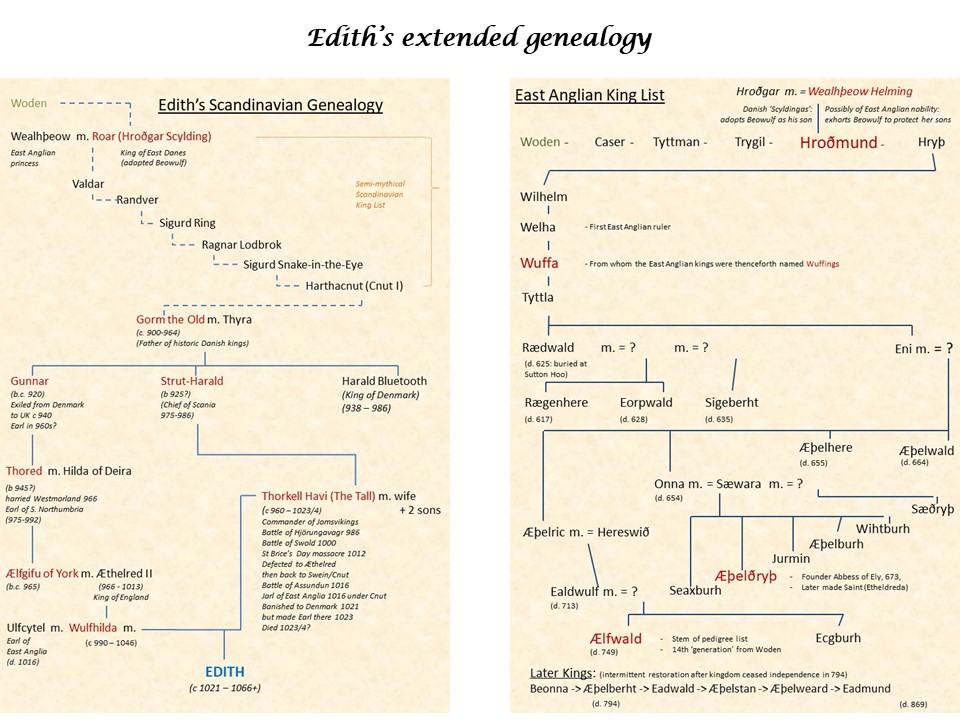Edith’s genealogy has for a long time been unknown or uncertain, not helped by early and completely erroneous speculation about her origins which posited that she was perhaps of lowly status and therefore of inconsequential origins. For example, it was often said that she was possibly a slave on one of Harold’s estates, such as Nazeing in Essex, whom he bedded and made pregnant. We now know this to be very far from the truth and possibly to be a story concocted to disenfranchise her and her family from any significant bearing on her times or the affairs of her husband, who became King Harold II of England in 1066. This diminishing of her existence and role has also often been compounded by her status as Harold’s ‘wife’ being questioned, not least by the Norman account of it where she is referred to as a ‘mistress’ or ‘concubine’.
Research has shown that she was a lady of high status and significant wealth (see ‘Edith’s Landholdings’) as well as a legitimate and long-term (over 20 years) consort of Earl, and then King, Harold and mother of at least seven children by him. We know that she was formally married to him through the legitimate ritual of ‘Hand-fasting’ (a process known as mores danico – in the Danish fashion, but outside the auspices of the Church) which is still a vibrant and popular method of betrothal today. So she was a significant person in her own right and deserves an acknowledged place in the history of her times.
Today we can also say that she is almost certain to have been a granddaughter of Aethelred the Unready via her mother, Wulfgyth/Wulfhilda, who was one of many children he had with his first (some say second) wife, Aelfgifu of York. She was also a possible daughter of a Viking chieftain, Thorkell the Tall, who was once in Aethelred’s army and who married Aethelred’s daughter after killing her husband Ulfkytel at the Battle of Assundun in 1016. These relationships are shown in the diagram below (where she is referred to by her Latin name, Eddeva). Interestingly, as Aethelred subsequently married Emma of Normandy and had three children by her, one of whom was Edward the Confessor, we can also be sure that Edith was the latter’s half-niece and was acknowledged and treated as such by him. In fact, there is much to suggest that Edward was also instrumental in Edith and Harold getting together following his appointment of Harold as Earl of East Anglia in 1045 (where Edith had many of her estates and which was her regional base – see the ‘Landboc’ for details of her estates and ‘The Crowhurst Yew’ for a dramatisation of her marriage to Harold and the process leading up to it).

If we examine further her wider ancestry, as shown in the following two charts (one of her Scandinavian heritage, the other of an old Anglian king list dating from 743), we can see that Edith was of Scandinavian – chiefly Danish – extraction, or connection, on both sides.

On one side (the Scandinavian pedigree) both her paternal and maternal lines lead back through the acknowledged father of modern Danish kingship, Gorm the Old, to Roar/Hrothgar, and then to Woden. On the other (the old Anglian king list dating to 743) the path ascends through St Edmund (the original patron saint of England, and the last ‘Wuffing’ king of East Anglia) back through Raedwald (the king purported to have been buried at Sutton Hoo) and Wuffa (the founder of the East Anglian dynasty) through to Hrothmund (the son of Hrothgar, the famous king described in our oldest epic poem, Beowulf – the origins of which may go back to the late 6th Century) and his wife, Queen Wealtheow, and thence again to Woden (the ‘founding’ deity to which all paths lead).
These pedigrees and their importance are detailed in our forthcoming book, the ‘Wyrtruman of Eadgifu – Book One; Family’ and their meaning for and impact on Edith are the subject of detailed current research which will be the subject of a future publication, the ‘Wyrtruman of Eadgifu – Book Two: Beliefs’. Both books will be available through our Merchandise page in due course.
